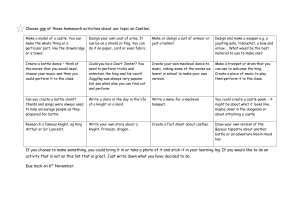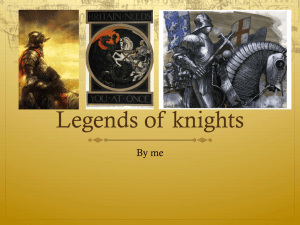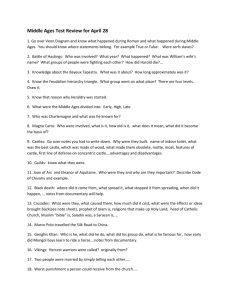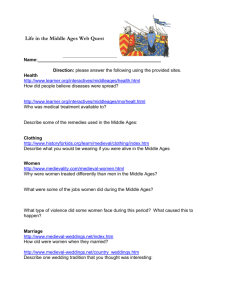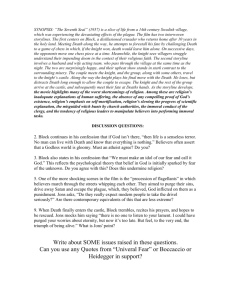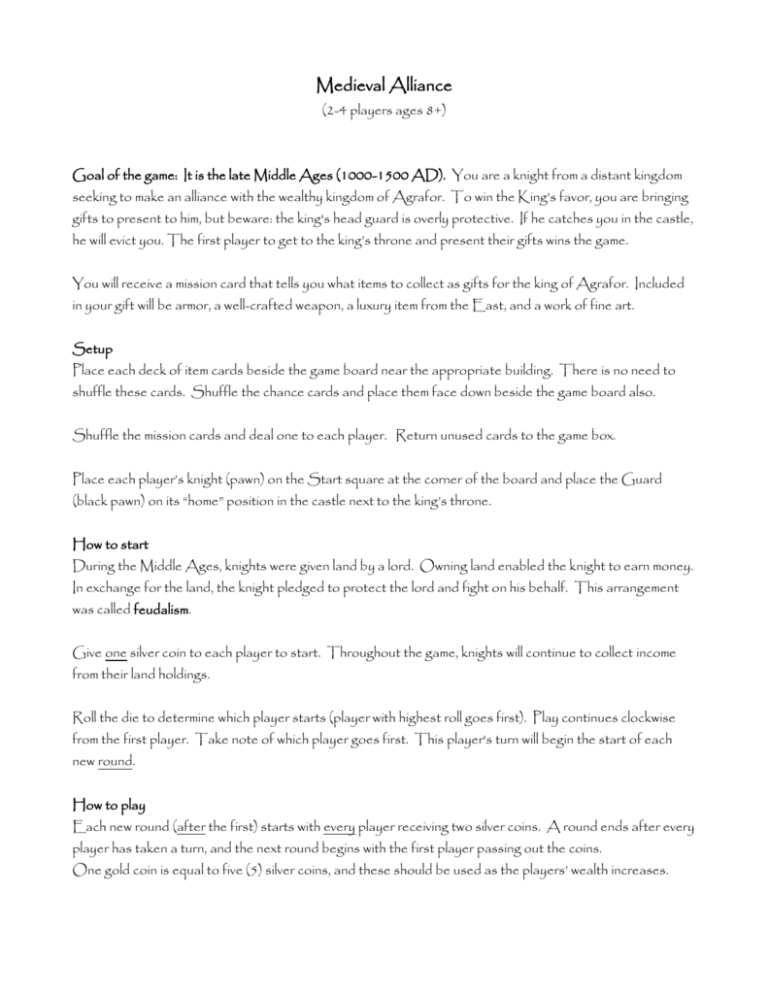
Medieval Alliance
(2-4 players ages 8+)
Goal of the game: It is the late Middle Ages (1000-1500 AD). You are a knight from a distant kingdom
seeking to make an alliance with the wealthy kingdom of Agrafor. To win the King’s favor, you are bringing
gifts to present to him, but beware: the king's head guard is overly protective. If he catches you in the castle,
he will evict you. The first player to get to the king’s throne and present their gifts wins the game.
You will receive a mission card that tells you what items to collect as gifts for the king of Agrafor. Included
in your gift will be armor, a well-crafted weapon, a luxury item from the East, and a work of fine art.
Setup
Place each deck of item cards beside the game board near the appropriate building. There is no need to
shuffle these cards. Shuffle the chance cards and place them face down beside the game board also.
Shuffle the mission cards and deal one to each player. Return unused cards to the game box.
Place each player’s knight (pawn) on the Start square at the corner of the board and place the Guard
(black pawn) on its “home” position in the castle next to the king’s throne.
How to start
During the Middle Ages, knights were given land by a lord. Owning land enabled the knight to earn money.
In exchange for the land, the knight pledged to protect the lord and fight on his behalf. This arrangement
was called feudalism.
Give one silver coin to each player to start. Throughout the game, knights will continue to collect income
from their land holdings.
Roll the die to determine which player starts (player with highest roll goes first). Play continues clockwise
from the first player. Take note of which player goes first. This player's turn will begin the start of each
new round.
How to play
Each new round (after the first) starts with every player receiving two silver coins. A round ends after every
player has taken a turn, and the next round begins with the first player passing out the coins.
One gold coin is equal to five (5) silver coins, and these should be used as the players’ wealth increases.
Movement on the Board
Your first action on every turn is to move your knight. Roll one of the movement dice and move the number
of spaces indicated on the die. You may move your player along any of the paths on the board. You may
change directions from one turn to the next, but you may not backtrack within a single move.
You must move the full number of spaces determined by the roll of the die unless your move takes you into a
building, or your knight is in the castle (more on this below). If your knight’s move crosses the landing of any
of the buildings, you may choose to either take your full move or stop at the building.
You may move a player through the tournament grounds without stopping if you wish (the tournament
grounds counts as one square).
You may move past another player on the board (count the square that is occupied when counting your
move). Two or more players may occupy the same space.
If you end your move on a space that is already occupied by another player, you may choose to challenge
the other player to a joust at the tournament grounds. For the joust, place the two dueling knights on the
tournament grounds. Each player rolls a movement die, and the player with the higher roll wins the joust.
The winner collects one silver coin from the other player, then moves his knight to either the Weapon Smith
or the Armor Smith (player’s choice), whereupon he has the option of purchasing an item from that shop
immediately. The knight who loses the joust loses his next turn.
Purchase of the Gifts
If you land on any of the buildings (Weapon Smith, Armor Smith, Market, or Shrine) that offer items for
sale (whether through a normal move or from the result of a tournament or chance card), you may choose,
during your current turn, to purchase the item identified on your Mission Card. To determine the price of
the item you wish to purchase, roll the yellow purchase die (faces of the die show numerals instead of dots),
and pay the amount indicated on the die. If you do not have enough money to make the purchase, your turn
ends with you purchasing nothing.
If you are inside a building (except the castle) at the beginning of your turn, you must roll the die and leave
the building on this turn; you cannot make a purchase at this point. Should you enter a building after this
movement, you obtain the option to purchase.
Chance Cards
If your knight ends his move on a square labeled “C”, take the top Chance card and read it aloud. Follow
the instructions on the card. When you are done with the Chance card, return it to the bottom of the deck
(face down).
Several of the Chance cards include century-specific information. In these cases, read only the section
appropriate for the century that your knight represents and follow the instructions indicated.
If a Chance card requires or allows action on a later turn, hold onto the card until you have completed that
action, then return it to the bottom of the deck. If a Chance card requires the player to lose a turn, the
player still collects income from their landholdings at the beginning of the round.
If a player does not have the money to pay for an event on a Chance card or to the winner of a joust, he
must return to the Start square on parole. This is the promise, on his honor, for the knight to return home
to obtain the money for the payment. The player must remain on the Start square until he has enough
coins to pay his debt. During this round the player pays the debt and resumes his play from the Start
square.
If the knight serves a ruler who reigns over more than one country, then for any chance card where the
country represented determines what action is performed, chose the action that pertains to the first country
listed.
Movement in the Castle
Knights may only enter the castle through the main gate after purchasing all the gifts on their Mission Card.
You may not enter through the “exit”. When in the castle, your knight may choose to move any distance up
to the amount indicated by the roll of the die. You may neither move your knight through nor land on a
square occupied by or adjacent to the guard. Squares diagonal to the guard are safe, and if there is a solid
wall between your knight and the guard, it is safe to land. While your knight is located inside the Castle, you
may not challenge another knight to a joust.
The castle guard remains in his “home” position (beside the king’s throne) until a player enters the castle.
Once a player enters the castle, the guard begins to patrol. At the end of every round in which one or more
players has a knight in the castle, roll one of the movement dice and place the guard on the square with the
matching number (players take turns rolling for the guard). If the guard lands on a square occupied by or
adjacent to a knight, the knight is evicted from the castle – place the evicted knight on the square
immediately outside of the “exit” on the side of the castle. To re-enter the castle, the banished knight must
use the front gate.
The guard, when moved, does not travel along the squares of the board like the players but is moved
directly to the next location indicated by the roll of the die. Players are not evicted from the castle if the
guard “passes through” their square.
If at any point there are no longer any knights in the castle, the guard is placed back at his “home” position
at the end of the round.
To win the game, your knight must land on the king’s throne in the castle to present your gifts.
Contents
Game Board
Coins: 20 - gold and 30 - silver
Purchase Die: 1 Yellow. Sides = 5,5,6,7,7,8
Movement Dice: 2 White. Standard 6-sided
Pawns: 5. (Four players; one guard)
Mission cards: 8.
Armor Smith, Weapon Smith, Shrine, and Market cards: 8 of each type.
Chance cards: 35.
Notes To Parents and Teachers
We, from Jett Educational Games LLC, thank you for purchasing Medieval Alliance. The goal of the
game is to teach historical facts and context regarding the Middle Ages (c. 1000-1500 AD). This
includes not only specific details, but also the time frame and how these facts influenced the medieval world.
From this base, the instructor can extend that knowledge to how the contemporary world has been
impacted. This is a broad endeavor, and here is some information that may assist you.
General Notes:
The Middle Ages extends roughly from 500 A.D. to 1500 A.D. This time period is broken down further
into three major eras: The Early Middle Ages (500-1000 A.D.), The High Middle Ages (1000-1300
A.D.), and the Late Middle Ages (1300-1500 A.D.). When playing Medieval Alliance, children have an
opportunity to learn important facts about Europe in the High and Late Middle Ages (1000-1500 A.D.)
through the use of “Chance” cards that influence the play of the game.
Belief in Christianity was a central part of European Medieval life. Most art was a representation of
scenes from the Bible or of important religious figures. Given the importance of religion during the Middle
Ages, in most cases in the game players collect a religious icon (an artistic representation of an important
person or event in religious history) as the work of fine art to include among their gifts for the king of
Agrafor.
The pricing of goods during the Middle Ages was not an exact science. Use of currency was fairly new to
Europe and there were not standards of measurement that determined the value of a given coin. A gold or
silver coin would have very different purchasing power from one region to the next, and certainly from one
century to another. In order to incorporate this uncertainty into the game, we use the Purchase die that the
player rolls to determine the price of their goods rather than setting a fixed price on the item cards.
The vocabulary on the Chance cards is at times advanced, so younger players may need some assistance
from parents or older players when reading the cards.
Why study the Middle Ages?
The study of history in general is an invaluable tool for learning about our contemporary world. Many of
the skills used to study history can be applied to the study of the events in our time. Studying history can
also identify the actions that lead to success, and can help prevent repeating past mistakes.
The events during the Middle Ages had a tremendous bearing on the development of the Western
Hemisphere. Not only was Europe impacted by these events, but also the histories North and South
America were directly influenced by these centuries. This impact was even felt in parts of Africa and Asia.
All areas of modern life, including commerce, religion, science and medicine, law and politics were shaped by
the people and events of this period.
Additionally, the settings and activities of this period, from the gallantry of knighthood to the humility of the
monastery, have been glamorized by the popular arts. There is much interest and intrigue related to this era,
which makes it even more fun to study.
What is the educational format of Medieval Alliance?
The game uses several forms to teach the history of this era, and it can be used effectively in most any
educational environment, from one based in classical methods even to “unschooling”.
First, while the game board is not based on any specific historical region, it includes many features that
typify the geography of that time period.
Second, the Mission Item Cards each display pictures that are era specific. We have included fine art that
is century specific as a part of the quest. These images do far more to instill an appreciation of art (and
motivate the talent to produce it) than any written description can achieve. These images also accomplish
the artists’ desire of communicating what was important to the people of that day. We are grateful to the
Art Renewal Center (www.artrenewal.org) for the use of most of the images used here. Also included are
images of finely crafted weapons and armor, again era specific. These images are of reproductions from the
skilled hands of Arms and Armor, Inc. (www.armor.com). These images are equally inspirational and allow
the student to appreciate the handiwork of the artisans of that era. The botanical drawings of important
medieval plants were digitally reproduced by curators of the History & Special Collections, Louise M.
Darling Biomedical Library, UCLA. (http://unitproj.library.ucla.edu/biomed/spice/index.cfm). Finally,
we are grateful to the Marian Library/International Marian Research Institute at the University of
Dayton, Ohio, (http://www.udayton.edu/mary/marypage21.html) for providing us with the image of
“Koimesis” (falling asleep of Mary), a fine example of late 10th century art.
Finally, the Chance Cards contain historical facts and information about the period. Instead of asking rote
questions that require students to memorize a series of facts, the cards tell brief tales that invite the student
into the Middle Ages. As part of the play, students will meet and travel with prominent figures from these
centuries, including artists, scientists and authors. Students will also encounter life from this period, from
the mundane of the food and shelter of serfs, to the lofty pursuits of kings and popes.
We acknowledge that history does not always fit readily in a few sentences on a Chance Card. It is likely
that many students will read one of these cards and have more questions regarding the subject than before
the game started. However, if this sparks curiosity that leads to researching the topic more thoroughly, then
we consider this success.
What are some additional study resources?
We strongly encourage students and teachers to visit the sites that have supported us in the creation of
this game.
www.artrenewal.org is a fantastic on-line gallery of over 40,000 masterworks of fine art from several
centuries. Their efforts to preserve and cultivate awareness and skills of master artists is commendable and
an indispensable part of a sound education.
www.oakeshott.org is a site dedicated to the study of weapons and armor from the middle ages. It is
sponsored by www.armor.com , which produces fine replicas of middle ages weapons and armor.
The UCLA Biomedical Library site on Spices and their Use as Flavors and Medicines gives historical
and current information on many of the plants and spices that were in high demand in Medieval Europe.
http://unitproj.library.ucla.edu/biomed/spice/index.cfm
The information for this game was compiled from a variety of books and reference sources, some of which
are out of print, as well as sites on the internet. We encourage you to seek out several sources for your
studies, and compare them in order to discern what facts are consensually agreed upon, and to distill facts
from interpretation.
Additional questions for students:
When looking at the game board, why would the armor smith and weapon smith be so close together?
Why might the market be located so close to water?
What crops might be growing in the fields?
From what materials might the houses in the town be made? How would these materials change based on
location (north or south)? How did the choice of materials change from 1000 to 1500?
Artist Credits
Game board illustrated by Betsy Dill in Centreville, Virginia (www.betsydill.com). Copyright Jett
Educational Games, LLC. All rights reserved.
Game Box Top – “Famous Persons: Pippo Spano” by Andrea del Castagno, 1450, Fresco transferred
to wood.
Market Cards – “St. Eligius in His Workshop” by Petrus Christus, 1449, Oil on wood.
Chance Cards – “The Magician” by Hieronymus Bosch, 1475-1480, Oil on wood
Armor Cards – “The Ghent Altarpiece: Soldiers of Christ” (Detail) by Jan van Eyck, 1427-1430, Oil
on wood
Weapon Cards – “Simone de Varie Kneeling in Prayer” by Jean Fouquet, 1455, Tempera colors and
gold paint on parchment
Mission Cards – “Ambassadors Depart” by Vittore Carpaccio, 1495-1500, Oil on canvas.
Shrine cards:
Common side - “Pulpit” by Giovanni Pisano, 1302-1311, Marble
11 C – Scene from the Bayeux Tapestry, artist unknown, 1077, Embroidery
11 C – “Koimesis” (falling asleep of Mary), artist unknown, late 10th century, Ivory
12 C – “Deposition from the Cross”, Benedetto Antelami, 1178, Marble
13 C – “The Capture of the Christ” by Giovanni Cimabue, 1280, Fresco
13 C – “Nativity of the Virgin” by Pietro Cavallini, 1291, Mosaic
14 C – “St. Phillip” by Andrea Beauneveu, 1386, Illumination (oil on canvas)
14 C – “Appearance while the apostles are at Table” by Duccio di Buoninsegna, 1308-1311, Tempera
on wood
15 C – “The Madonna and Child Enthroned With Saint John the Baptist and Dorothy” by Lazzaro
Bastiani, 1470, Tempera on panel.
Designed and distributed by Jett Educational Games
Located in Belcamp, Maryland
http://mysite.verizon.net/jetted4/
All rights reserved

